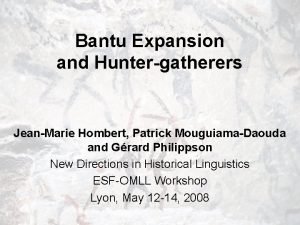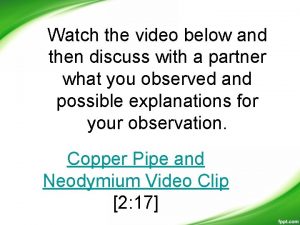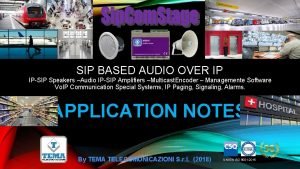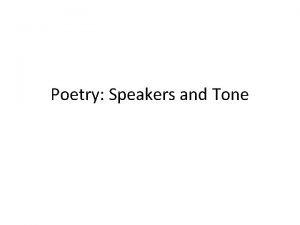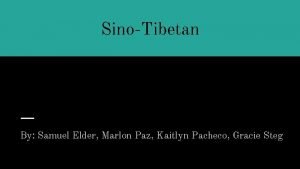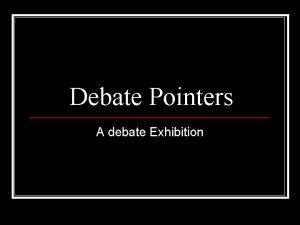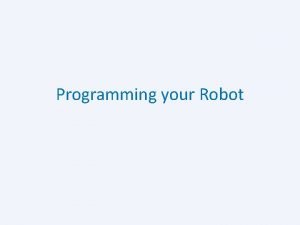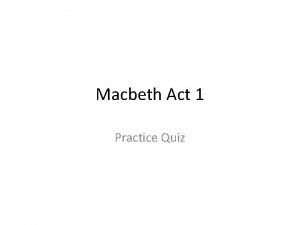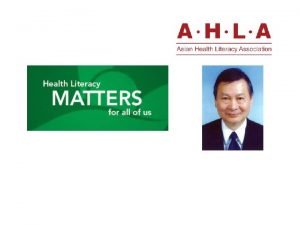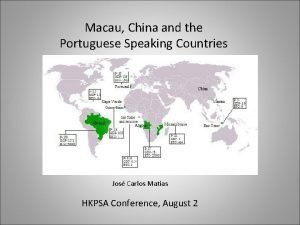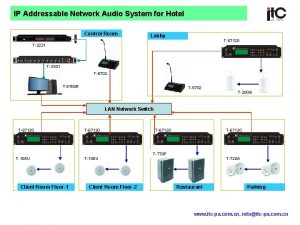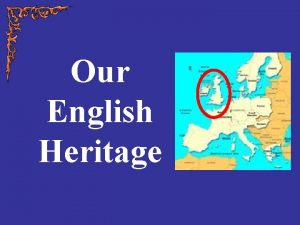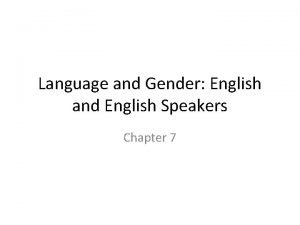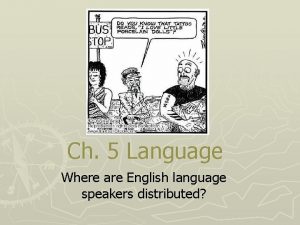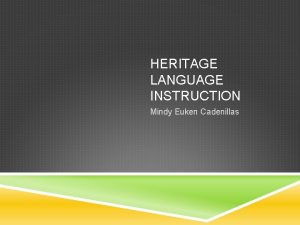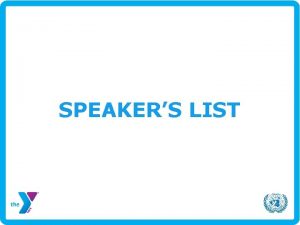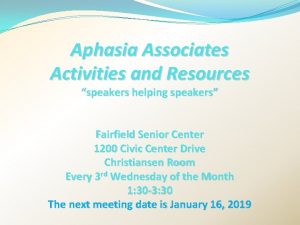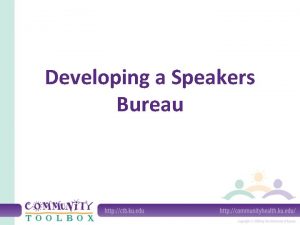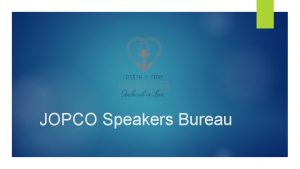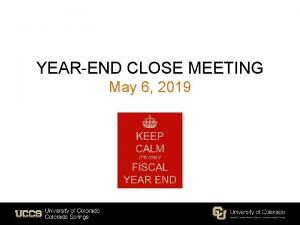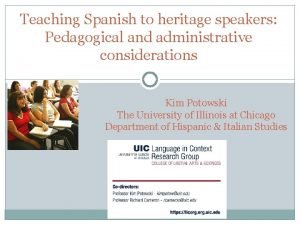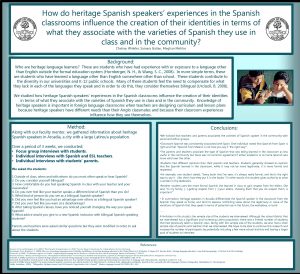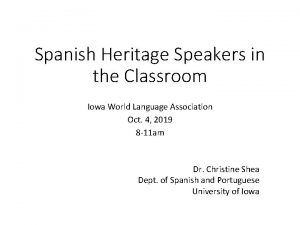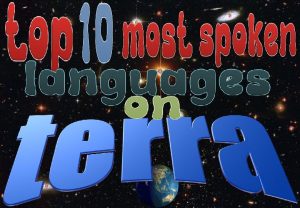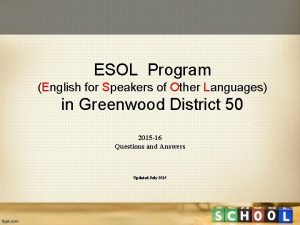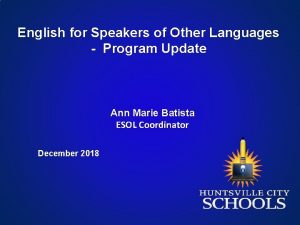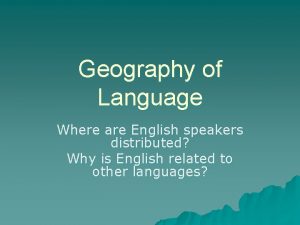The English for Heritage Language Speakers Program Language


























- Slides: 26

The English for Heritage Language Speakers Program

Language Proficiency in Government Service: The English for Heritage Language Speakers Program Deborah Kennedy, Director, EHLS Program, Center for Applied Linguistics Beth Mackey, Visiting Scholar, Center for Applied Linguistics Kevin Gormley, Senior Program Officer, National Security Education Program Interagency Language Roundtable, January 21, 2011 © 2011 Center for Applied Linguistics

Program Fundamentals n Legislation authored by the House Permanent Select Committee on Intelligence in FY 2005 n Providing English instruction to U. S. citizens who are native speakers of a critical language n Scholarships to individuals instructed at an institution of higher education n Federal service requirement of at least one year

Program History n n 2005: Feasibility study conducted by CAL 2006: Program initiated at Georgetown University and the University of Washington Language groups: Arabic, Chinese-Mandarin, Russian n 2007– 2008: Program in place at Georgetown University and the University of Washington Expansion to additional language groups n 2009– 2011: Program at Georgetown only Language groups recruited for 2011: Arabic, Chinese-Mandarin, Dari, Persian Farsi, Pashto, Hindi, Punjabi, Urdu, Igbo, Hausa, Somali, Swahili

Language Proficiency n Entrance Requirements ILR Level 3 / ACTFL Superior in the native language Only speaking proficiency is tested (OPI) ¨ ILR Level 2 / ACTFL Advanced-Low in English Listening and reading tests: ELPT from DLI-ELC Speaking test: OPI Writing test: modified DLI-ELC writing test ¨ n Exit Goals ¨ ILR Level 3 / ACTFL Superior in four English modalities

Instructional Program n Six-month intensive program Reading and Writing for Professionals ¨ Professional Oral Communications ¨ News Analysis ¨ Career Skills ¨ n Two-month part-time program Professional Writing ¨ Career Skills ¨

Capstone: Open Source Analytical Research Project n n Topics provided by federal agencies and matched to scholars’ backgrounds and expertise Scholars conduct research in English and the heritage language Each scholar works with a federal agency mentor Scholars present their analyses at a formal symposium and in a written paper

English Language Proficiency Outcomes Demographic data and outcomes are reported for the 104 scholars who have participated in the Georgetown University program. ¨ 2006: 7 Scholars ¨ 2007: 16 Scholars ¨ 2008: 16 Scholars ¨ 2009: 28 Scholars ¨ 2010: 37 Scholars

Demographics: Gender More men (60%) have participated in the program than women (40%)

Demographics: Age n Scholars’ average is 45 ¨ Mean = 44. 75 ¨ Median = 45 n The youngest scholar is 26 and the oldest is 64

Participant Age Summary (2006 -2010)

Demographics: Years in the US Scholars have lived in the U. S. for an average of almost 16 years, ranging from 3 to 42 years

Demographics: Language Background Language Arabic Mandarin Dari Urdu Persian Farsi Swahili Farsi Igbo Russian Other (Cantonese, Hausa, Korean, Pashto) Frequency 45 22 9 7 4 4 3 3 3 4 Percent 43. 3 21. 2 8. 7 6. 7 3. 8 2. 9 3. 8

Demographics: Other Languages Spoken n 63. 5% of scholars reported speaking at least one other language n French was the most commonly spoken other language, with 22. 1% of scholars speaking French

Demographics: Educational Background Highest Degree Received Frequency Percent Associate’s 1 0. 9 Bachelor’s 41 39. 4 Master’s 40 38. 5 Doctorate 6 5. 8 Not Collected 7 6. 7 Other 9 8. 7

Demographics: Educational Background 42 scholars have an additional second degree, and 6 scholars indicated a third degree n 62% of scholars have received at least one degree taught primarily in English n 55. 7% of scholars have received at least one degree from a university in the U. S. n

Reading Results (2006 -2010) Level 3 Level 2+ EXIT SCORE Level 2 ENTRY SCORE Level 1+ 0 10 20 30 40 50 60 70

Increases in Scores: Reading n The ceiling effect strongly influenced improvements in reading ¨ 50 out of the 104 scholars remained at Level n 3 However, results show that ¨ 13 scholars improved across the 2+/3 threshold ¨ 1 scholar improved from Level 2 to Level 3

Listening Results (2006 -2010) Level 3 Level 2+ EXIT SCORE Level 2 ENTRY SCORE Level 1+ Level 1 0 10 20 30 40 50 60

Increases in Scores: Listening 10 scholars crossed the 2+/3 threshold in Listening n 2 scholars raised their score from Level 2 to Level 3 n 18 scholars improved from Level 2 to Level 2+ n

Speaking Results (2006 -2010) Superior Advanced High Advanced Mid Advanced Low EXIT SCORE ENTRY SCORE Intermediate High Intermediate Mid Intermediate Low 0 5 10 15 20 25 30 35

Increases in Scores: Speaking n n 13 scholars crossed the threshold from the Intermediate Level to the Advanced Level 7 scholars crossed the threshold from the Advanced Level to the Superior Level 6 scholars improved within the Intermediate Level 15 scholars improved within the Advanced Level

Writing Results (2006 -2010) Superior Low Advanced High EXIT SCORE Advanced Mid ENTRY SCORE Advanced Low Intermediate High Intermediate Mid 0 10 20 30 40

Increases in Scores: Writing n n n 10 scholars crossed the threshold from the Intermediate Level to the Advanced Level 11 scholars crossed the threshold from the Advanced Level to the Superior Level 5 scholars improved within the Intermediate Level 25 scholars improved within the Advanced Level 3 scholars improved within the Superior Level

EHLS Graduates’ Current Employment n n n n n CIA – Open Source Works National Ground Intelligence Center, INSCOM DIA DLIFLC NGA FSI ODNI – Open Source Center US Naval Academy DOD Contractors (Concepts & Strategies, L-3, SAIC)

Thank You!
 Coparcenary property and separate property
Coparcenary property and separate property World heritage is our heritage slogan
World heritage is our heritage slogan Obstructed heritage in hindu law
Obstructed heritage in hindu law How to teach english to arabic speakers
How to teach english to arabic speakers Language speakers
Language speakers Currents and magnets summarizer
Currents and magnets summarizer Agora speakers international
Agora speakers international Audio over ip speakers
Audio over ip speakers Types of speakers in a poem
Types of speakers in a poem Regretful tone
Regretful tone Mande speakers
Mande speakers Nnnn speakers
Nnnn speakers Soundblock coaxial speakers creative commons pictures
Soundblock coaxial speakers creative commons pictures Stay you imperfect speakers tell me more
Stay you imperfect speakers tell me more Distinguished guests ladies and gentlemen
Distinguished guests ladies and gentlemen Agora speakers
Agora speakers Speakers
Speakers Portuguese speakers in macau
Portuguese speakers in macau Music system for hotel
Music system for hotel Fspos vägledning för kontinuitetshantering
Fspos vägledning för kontinuitetshantering Novell typiska drag
Novell typiska drag Tack för att ni lyssnade bild
Tack för att ni lyssnade bild Returpilarna
Returpilarna Shingelfrisyren
Shingelfrisyren En lathund för arbete med kontinuitetshantering
En lathund för arbete med kontinuitetshantering Särskild löneskatt för pensionskostnader
Särskild löneskatt för pensionskostnader Vilotidsbok
Vilotidsbok




